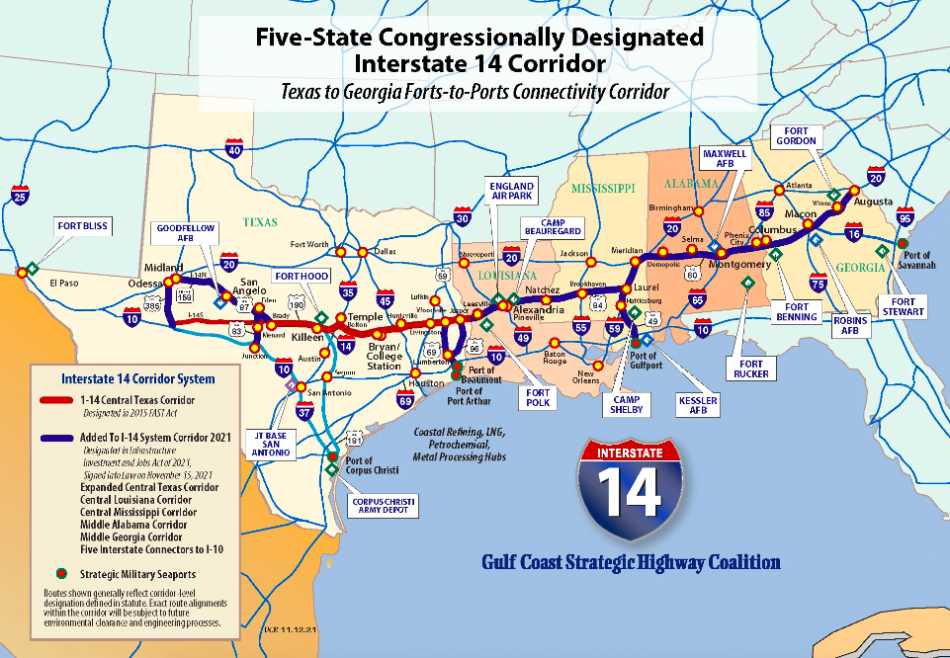You may not have heard of Interstate 14 until now, and even if you have, you may disregard I-14 as unimportant because its future routing would cut through the middle of Georgia, roughly an hour south of Atlanta.
Congressionally designated in 2022 and partly built in Texas, plans for I-14 in Georgia call for upgrades to the Fall Line Freeway from Columbus to Augusta, making it the Peach State’s first new interstate since the 1960s. (For a quick I-14 primer, check out this video). But I posit that I-14 is equally—if not more—important to the Atlanta metropolitan area as it is to middle Georgia.
On average, Atlantans lose $1,900, or 56 hours, in productivity per year from sitting in traffic congestion. Over the past 60 years, the Georgia Department of Transportation has added lanes to I-85, I-75, I-20, and I-285 as a supposed solution to Atlanta's traffic woes.
If you live in Atlanta, or have visited the city even once, you know GDOT’s supposed remedy has not quelled the problem. In fact, traffic has worsened, to the point it's nationally infamous.
Engineers today acknowledge that adding new lanes to currently congested roads usually makes traffic worse because of induced demand. Congestion constrains demand. Thus, after widening occurs, and flow improves in the short-term, latent trips become reality. The new lanes rapidly fill up with traffic and the cycle repeats itself.
Despite best road-building practices, GDOT’s plans call for additional truck lanes to be added to I-75, costing around $2 billion in state funds. These new lanes will only put more strain on Atlanta highways.
The only solution to address congestion (outside of alternate and public transportation options) is to take vehicles off Atlanta highways. One way to accomplish this is with an alternative highway route—which, yes, is where I-14 and middle Georgia come in.
 The five-state, Congressionally designated I-14 corridor. A 25-mile section in Texas expanded a highway and opened in 2017. Gulf Coast Strategic Highway Coalition
The five-state, Congressionally designated I-14 corridor. A 25-mile section in Texas expanded a highway and opened in 2017. Gulf Coast Strategic Highway Coalition
This might be hard to conceptualize for Atlantans, but middle Georgia suffers from too little traffic. Lack of traffic has led to an inadequate supply of funding for quality infrastructure. State dollars are allocated primarily according to demand, thus little traffic equates to few dollars. Less traffic also squashes vital sales tax revenue and income from tourism or local governments.
This inability to construct critical projects has led to a lack of private sector investment. Shipping goods and connecting people is more cost-effective and time-efficient on the interstate system. Moreover, interstate-grade highways boast greater safety and utility compared to other highway forms. For these reasons, the private sector looks to locate elsewhere, creating an inequity in the quantity of quality jobs. Economic immobility and poverty then persist.
Even when people from middle Georgia attain high school and college degrees, they often do not remain in the region because of lack of opportunity—brain drain. I-14 will address this lack of infrastructure, quality jobs, and opportunity.
A more pressing matter for many metro Atlantans—gridlock on I-20, a main east-west connector across the state—could be helped by I-14. The new interstate would siphon away I-20 drivers and provide an alternative for travelers and truckers that doesn’t involve rolling the dice on trying to drive through Atlanta to reach, say, Augusta. Or vice versa.
Aside from increased traffic congestion, the widening of Atlanta’s highways has caused social division. The more than 270-foot rift between neighborhoods in Atlanta causes incoherency within the community, as separate communities form with less connection between one another. While plans like the Midtown Connector Park seek to address this cohesion issue, the underlying problem of why the highway had to be widened so much will not be solved. I-14 instead looks to widen and enhance highways that are already there.
All in all, what is one region’s problem can be a solution to solving problems in the other region. Atlanta needs less traffic to relieve congestion and to repair divided communities, while middle Georgia needs more traffic to create greater economic opportunities. I-14 is key to a more vibrant and prosperous Georgia.
Frank Lumpkin, president and Georgia representative for the Youth Infrastructure Coalition, is a third-year law student at University of Georgia
...
Follow us on social media:
• The case for pedestrianizing downtown Athens (Urbanize Atlanta)






